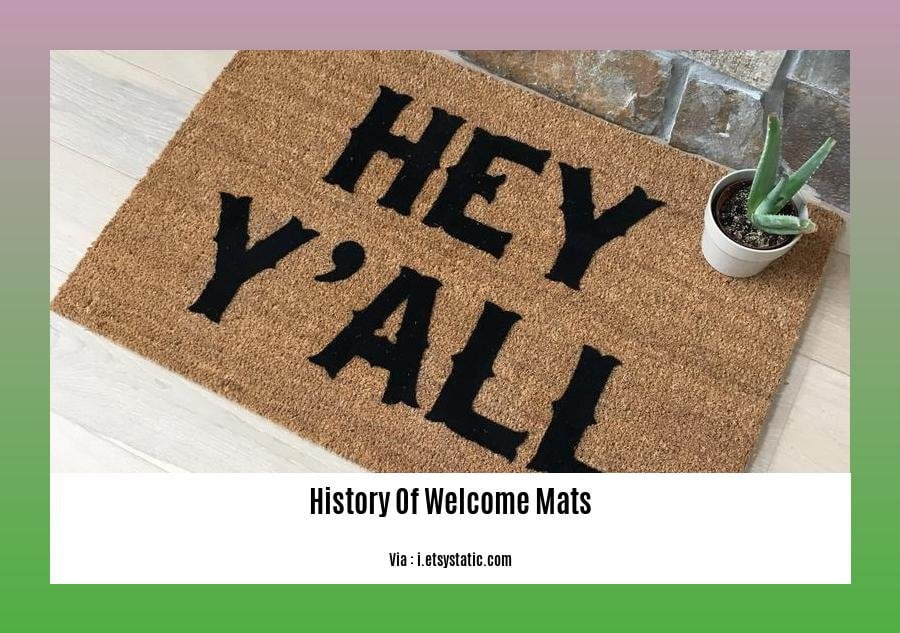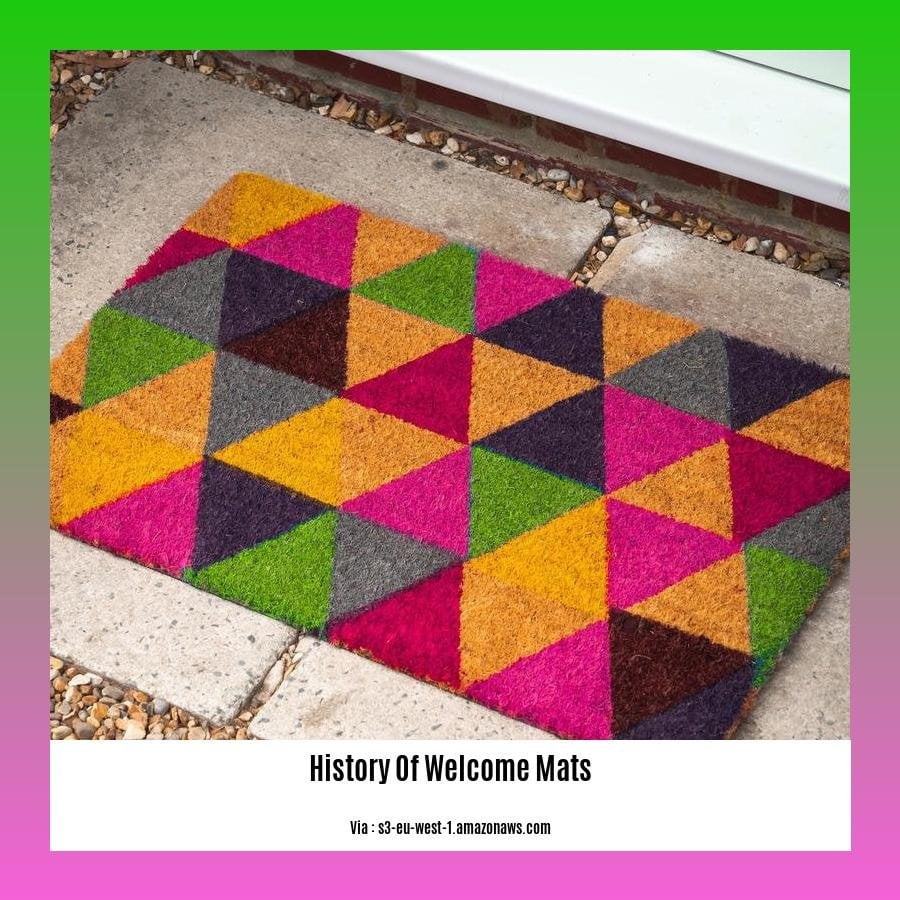Embark on a captivating journey through the history of welcome mats, exploring their transformation from humble beginnings to becoming iconic doorstep symbols. These seemingly ordinary objects hold a wealth of stories, reflecting cultural shifts, technological advancements, and societal norms. Discover how welcome mats have evolved over the centuries, from practical protectors to expressions of personal style and symbols of hospitality.
Key Takeaways:
-
The term “welcome mat” emerged in 1946, while “doormat” dates back to 1665.
-
The word “welcome” originates from Old English, while “doormat” may have roots in Latin.
-
Early humans utilized materials like grasses, barks, and herbs as floor coverings.
History of Welcome Mats: A Journey from Humble Beginnings to Doorstep Icons

“Welcome” – a word that exudes warmth, hospitality, and a sense of belonging. And what better way to convey this sentiment than with a humble yet essential household item – the welcome mat? Let’s embark on a journey through time to trace the evolution of these doorstep icons.
From humble origins to decorative expressions
The concept of floor coverings can be traced back to the earliest civilizations. Early humans used natural materials like grasses, barks, and herbs to create mats that served both practical and aesthetic purposes. These mats were placed at the entrance of dwellings to keep dirt and debris from entering.
The birth of “welcome mats” and “doormats”
The term “doormat” emerged in the mid-17th century, derived from the Latin word “doormata,” meaning “doorkeeper.” It initially referred to a person who tended to the door, but over time, the term evolved to describe the mat placed outside the door.
In the early 20th century, the term “welcome mat” gained popularity, emphasizing the mat’s role in welcoming guests and creating a warm and inviting atmosphere. The introduction of synthetic materials like coir, nylon, and rubber led to a surge in the production of durable and decorative welcome mats.
Welcome mats: A canvas for creativity
Today, welcome mats are not just functional items; they are also a form of self-expression. From whimsical designs to personalized messages, welcome mats add a touch of personality to any doorstep. They reflect the homeowner’s style, taste, and sense of humor.
The cultural significance of welcome mats
Welcome mats hold cultural significance beyond their practical purpose. In many cultures, they are seen as a symbol of hospitality and a gesture of welcome. Placing a welcome mat outside the door is a way to invite guests into one’s home with open arms.
In the United States, welcome mats often feature patriotic symbols, such as the American flag or the bald eagle. These mats serve as a subtle display of national pride and patriotism.
Conclusion
From humble beginnings as floor coverings to decorative expressions of personality and cultural symbols, welcome mats have come a long way. They have transformed from purely functional items to objects that reflect our style, values, and sense of hospitality. As we step onto a welcome mat, we not only enter a home but also a world of warmth, welcome, and belonging.
-
Want to learn about the fascinating history of weaving? Explore our comprehensive article here.
-
Interested in the evolution of weaving looms? Dive into the depths of their history here.
-
Discover the rich history of the renowned luxury skincare brand, History of Whoo, and immerse yourself in its legacy of innovation.
Symbolic Meanings and Superstitions Associated with Welcome Mats
Welcome mats, those humble yet essential household items, have a rich history steeped in symbolism and superstition. Initially crafted from natural materials like grasses and barks, they provided warmth, dryness, and comfort while also serving as a protective barrier against the elements. Over time, welcome mats evolved into decorative expressions of personality, cultural symbols, and good luck charms.
Superstitions
-
A Clean Welcome Mat: Symbolizes a welcoming and hospitable home, attracting positive energy and good fortune.
-
Placement: Placing a welcome mat outside your door is believed to invite prosperity and happiness into your home.
-
Color: Different colors carry different meanings. For example, green symbolizes prosperity, red represents passion and protection, and blue brings tranquility.
-
Symbols: Some mats feature symbols like the horseshoe, which is believed to bring good luck, or the evil eye, which wards off negative energy.
Symbolic Meanings
-
Hospitality: A warm and inviting welcome mat signifies that your home is open to guests and that they are welcome to enter.
-
Protection: Welcome mats act as a protective barrier, keeping dirt, dust, and negative energy from entering your home.
-
Personality: Welcome mats reflect the homeowner’s style, taste, and sense of humor, adding a personal touch to the entrance of the home.
-
Cultural Expression: Welcome mats can represent cultural traditions and beliefs, such as the use of traditional designs or motifs in different cultures.
Key Takeaways:
- Welcome mats have evolved from practical floor coverings to decorative expressions of personality and cultural symbols.
- Superstitions associated with welcome mats include the belief that a clean mat attracts positive energy and good fortune, while the color and symbols on the mat can carry different meanings.
- Welcome mats serve as a protective barrier against dirt, dust, and negative energy while also symbolizing hospitality and welcoming guests into the home.
Sources:
Welcome mats as a form of self-expression and storytelling

For centuries, welcome mats have served as more than just functional floor coverings; they have evolved into expressive tools of self-revelation and compelling narratives. From ancient origins to modern-day expressions, welcome mats have captured the essence of cultures, celebrated individuality, and welcomed guests with unique stories.
The Canvas of Self-Expression:
Welcome mats offer a blank canvas for homeowners to showcase their personality, interests, and values. Whether it’s a quirky design, a humorous message, or a vibrant pattern, doormats act as silent storytellers, inviting visitors to unravel the tale behind the threshold.
Storytelling Through Designs:
Designs on welcome mats often hold deep meaning and symbolism. A nature-inspired mat might reflect the homeowner’s love for the outdoors, while a whimsical design could reveal a playful personality. Patriotic symbols, such as the American flag or the bald eagle, symbolize national pride and patriotism.
Celebrating Cultural Traditions:
Welcome mats also serve as cultural ambassadors, reflecting the traditions and heritage of a region. In many cultures, intricate woven mats are crafted using traditional techniques, each pattern carrying stories of ancestral wisdom and craftsmanship.
Welcoming Guests with Warmth:
Beyond their aesthetic appeal, welcome mats embody the spirit of hospitality. They extend a warm invitation to guests, creating a welcoming atmosphere from the moment they step onto the doorstep.
Key Takeaways:
- Welcome mats have evolved from practical floor coverings to decorative expressions of personality and cultural symbols.
- Designs on welcome mats often hold deep meaning and symbolism, reflecting the homeowner’s interests, values, and cultural heritage.
- Welcome mats serve as silent storytellers, inviting visitors to unravel the tale behind the threshold.
- They create a welcoming atmosphere, extending a warm invitation to guests from the moment they step onto the doorstep.
Citations:
- The Unknown History of Welcome Mats & Doormats
- 50 Unbelievable Facts About the History of Welcome Mats – 2024
Evolution of Materials and Designs in Welcome Mats
Welcome mats have undergone a remarkable transformation over the centuries. From humble beginnings as natural floor coverings to decorative expressions of personality and cultural symbols, welcome mats have seen it all.
Early Beginnings: Natural Materials and Practicality
In the early days, humans turned to nature for materials to create mats. Grasses, barks, and herbs were woven together to form mats that offered warmth, dryness, and comfort. These mats served both practical and aesthetic purposes, adding a touch of coziness to the entrance of dwellings.
Mesopotamia and Symbolism: Cleansing and Welcoming
In ancient Mesopotamia, welcome mats took on a deeper significance. They were not just floor coverings; they became symbols of hospitality and purification. These mats were placed at the entrance of homes to cleanse guests of the outside world, creating a welcoming and inviting atmosphere.
Ancient Greece and Rome: Decorative Art and Protection
In ancient Greece and Rome, welcome mats evolved into decorative works of art. Intricate mosaics or patterns adorned these mats, imbuing them with protective qualities. They were believed to ward off evil spirits and bring good fortune to the home.
Medieval Europe: Simplicity and Functionality
In Medieval Europe, welcome mats returned to their simpler roots. Made from basic materials like straw or rags, these mats were primarily designed to keep dirt and mud from being tracked into homes. The focus was on functionality rather than ornamentation.
Modern Era: Diversity and Personal Expression
The modern era ushered in a new era of welcome mats, characterized by diversity and personal expression. Today, welcome mats are crafted from a wide range of materials, including coir, rubber, nylon, and even recycled materials. They come in various sizes, shapes, and designs, catering to every taste and style.
From natural fibers to intricate mosaics, from symbols of hospitality to expressions of personality, welcome mats have come a long way. Each era has left its unique imprint on these humble items, transforming them into the decorative and functional icons they are today.
Key Takeaways:
-
Welcome mats have evolved from simple floor coverings to expressions of personality and cultural symbols.
-
Early mats were made from natural materials like grasses, barks, and herbs.
-
In ancient Mesopotamia, welcome mats had a symbolic purpose, cleansing guests of the outside world.
-
Ancient Greece and Rome decorated welcome mats with intricate mosaics or patterns for protection.
-
Modern welcome mats come in various materials, sizes, shapes, and designs, reflecting personal style and taste.
Citations:
FAQ
Q1: Where did the term “welcome mat” originate?
A1: The term “welcome mat” was first coined in 1946, tracing its roots back to the Old English word “wilcuma,” meaning “welcome.” On the other hand, the term “doormat” has been in use since 1665, potentially derived from the Latin word “doormata,” meaning “doorkeeper.”
Q2: When were welcome mats first used?
A2: Welcome mats have a rich history, dating back to ancient Egypt. These early welcome mats, crafted from natural materials like grasses, barks, and herbs, provided warmth, dryness, and comfort.
Q3: What was the significance of welcome mats in ancient Mesopotamia?
A3: In ancient Mesopotamia, welcome mats played a crucial functional and symbolic role. They served to cleanse guests of the outside world’s dust and debris, symbolizing a warm and welcoming gesture into the home.
Q4: How did ancient Greece and Rome incorporate welcome mats into their cultures?
A4: Ancient Greeks and Romans adorned their welcome mats with intricate mosaics or patterns, imbuing them with symbolic meanings of protection and hospitality.
Q5: How did welcome mats evolve during the Medieval period?
A5: During the Medieval period, welcome mats were primarily used to prevent dirt and mud from being tracked into homes. They were often crafted from simple materials like straw or rags, emphasizing their functional purpose.
- Unraveling Einstein’s Legacy: Who Inherited His Genius? - July 14, 2025
- Unlock Einstein’s Family Tree: Bernhard Caesar & Untold Stories - July 14, 2025
- Unveiling Bernhard Caesar Einstein: His Life & Albert Einstein’s Legacy - July 14, 2025
















